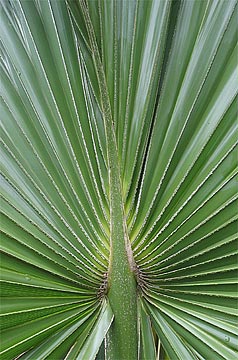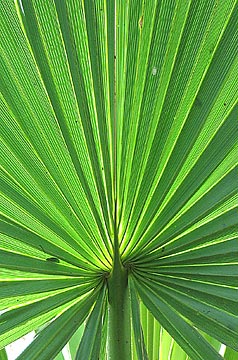by Bob Harms
The Brazoria Sabal Palmetto (Sabal × brazoriensis)
San Bernard National Wildlife Refuge, Brazoria County, TX
Until recently the palmetto population in SW Brazoria County remained a taxonomic puzzle. Botanists, even those specializing in palms, either tended to ignore this population or present speculations without compelling evidence. New genetic research by Douglas Goldman provides strong evidence that it is "a hybrid, but an old one, with clear genetic distinctiveness," with a validly published name, Sabal × brazoriensis. Goldman's work seems to confirm unpublished earlier work of Mark Brunell (Origin and relationships of the Brazoria palmetto (Arecaceae: Sabal) based on AFLP data), and suggests:a closer affinity of the putative hybrid with S. minor and S. palmetto than with S. mexicana, excluding the latter species from possible parentage.The possibility of Sabal hybrids had been around for a long time and was noted in Scott Zona's [Flora of North America Sabal article.]
The Brazoria palmetto is easily distinguished from S. minor (dwarf palmetto) by its often strongly costapalmate leaves* and, when mature, by its trunk; from S. mexicana (Texas palmetto) by its small fruits (cf. fruit comparison). Evidence from juvenile ontogeny would seem to distinguish it from S. minor, S. palmetto and S. mexicana. The possibility of a connection with the wild Sabal population in Fayette County - never studied - cannot be ruled out.
*Goldman notes that blades vary from "relatively flat to strongly costapalmate, the latter unlike S. minor."
The images below are of a Brazoria Sabal palmetto grown from seed from Brazoria County at the Rare Plants Study Center by Marshall Johnston and Anders Saustrup. The small palm from a 1-gallon container was planted in N. Hays County in the Texas hill country, in a constant seep with full sun in 1977. After that it received no care.



S. mexicana — S. minor — Sabal × brazoriensis
strongly costapalmate weakly costapalmate — strongly costapalmate
Abaxial (bottom side) view of the midribs of Texas Sabal species
The costa (midrib) is an extension of the leaf stalk (petiole), clearly visible here. Viewed from the top (adaxial) side S. minor, with its short midrib, typically appears to be palmate, since all leaf segments radiate from the immediate area of the hastula.
Brazoria Palm (Sabal x brazoriensis)
Palm Unit, San Bernard National Wildlife Refuge
Dwarf Palmetto (Sabal minor)
Palm Unit, San Bernard National Wildlife Refuge


